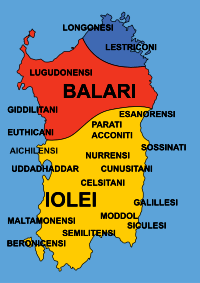List of ancient Corsican and Sardinian tribes


This is a list of ancient Corsican and Sardinian tribes, listed in order of the province (Roman province) or the general area in which they lived. Some closely fit the concept of a tribe. Others are confederations or even unions of tribes.
Overview
Before the Roman conquest in the 3rd century BC, the islands of Corsica and Sardinia were inhabited by three main peoples or ethnic groups, the Corsi, the Balares, and the Ilienses, each of them divided into several tribes. With the Roman conquest, the province of Sardinia and Corsica was created, becoming the second province of the Roman Republic to be created after that of Sicily.
The ethnic and linguistic affiliation (Paleo-Sardinian language) of the Nuragic people and tribes remains to be further studied, moreover "Nuragic" might have also been a geographical and historical name designating different peoples and languages, rather than indicating a single origin. Current knowledge indicates that they may have been related to the Iberians and the ancient Basque: these peoples were Pre-Indo-Europeans and spoke Pre-Indo-European languages, Proto-Basque (the ancestor of modern Basque) and Iberian.[1] There is also the possibility that the Nuragic peoples may have been related to the Etruscans and other Tyrsenian peoples and languages.[2] One of the Sea Peoples (the Shardana or Sherden) may have been either a population hailing from Sardinia (Ugas 2005, 2016) or a group of tribes that migrated to the island in the Late Bronze Age (Sandars 1978).
If the Corsi, dwelling in Corsica and in the northernmost tip of Sardinia (Gallura), were a subset of the Ligurians[3] and a group of tribes (they probably were an Indo-European people related to the Celts), then they would have been of a different ethnic and linguistic affiliation from the majority of the tribes of Sardinia (although Emidio De Felice found similarities between Paleo-Sardinian and Ancient Ligurian[4]).
The ancient Sardinian and Corsican tribes are the ancestors of most present-day native Sardinians[5] and Corsicans, and their language or languages, like Paleo-Sardinian and Paleo-Corsican, are the substrate of the modern Sardinian and Corsican languages, now part of the Neo-Latin branch.
Corsica et Sardinia
Corsica
Sardinia
- Ligures?
- Corsi
- Corsi Proper, they dwelt at the extreme north-east of Sardinia, near the Tibulati and immediately north of the Coracenses.
- Lestricones/Lestrigones (Lestriconi/Lestrigoni)
- Longonenses (Longonensi)
- Tibulati, they dwelt at the extreme north of Sardinia, about the ancient city of Tibula, near the Corsi (for whom Corsica is named) and immediately north of the Coracenses.
- Corsi
- Balares (Balari)
- Euthicani
- Giddilitani
- Lucuidonenses/Lugudonenses (Lugudonensi), they dwelt south of the Carenses and the Cunusitani and north of the Æsaronenses
- Nurrenses (Nurrensi), in Nurra territory, not the same tribe as the Norenses/Noritani)
- Ilienses/Iolaes/Diagesbes (Iliensi/Iolaei)
- Acconiti
- Aechilenenses/Cornenses (Aichilensi), they dwelt south of the Æsaronenses and north of the Rucensi.
- Aesaronenses (Esanorensi), they dwelt south of the Salcitani and the Lucuidonenses and north of the Æchilenenses or Cornenses.
- Beronicenses (Beronicensi)
- Carenses, they dwelt south of the Coracenses and north of the Salcitani and the Lucuidonenses.
- Celsitani, they dwelt south of the Rucensi and north of the Scapitani and the Siculensi.
- Coracenses, they dwelt south of the Tibulati and the Corsi (for whom Corsica is named) and north of the Carenses and the Cunusitani
- Corpicenses, they dwelt south of the Rucensi and north of the Scapitani and the Siculensi.
- Cunusitani, they dwelt south of the Coracenses and north of the Salcitani and the Lucuidonenses.
- Galillenses (Galillesi)
- Maltamonenses (Maltamonensi)
- Moddoli
- Neapolitani, they dwelt south of the Scapitani and the Siculensi and north of the Solcitani and the Noritani.
- Noritani/Norenses, they dwelt at the extreme south part of the island, immediately south of the Neapolitani and the Valentini
- Parati
- Rucensi, they dwelt south of the Æchilenenses (also called Cornenses) and north of the Celsitani and the Corpicenses
- Salcitani, they dwelt south of the Carenses and the Cunusitani and north of the Æsaronenses.
- Scapitani, they dwelt south of the Celsitani and the Corpicenses and north of the Neapolitani and the Valentini
- Semilitenses (Semilitensi)
- Siculensi (Siculesi), they dwelt south of the Celsitani and the Corpicenses and north of the Neapolitani and the Valentini.
- Solcitani, they dwelt at the extreme south part of Sardinia, immediately south of the Neapolitani and the Valentini
- Sossinates (Sossinati)
- Uddadhaddari
- Valentini, they dwelt south of the Scapitani and the Siculensi and north of the Solcitani and the Noritani.
See also
Notes
- ↑ Eduardo Blasco Ferrer, Paleosardo. Le radici linguistiche della Sardegna neolitica, Berlin/New York (2010)
- ↑ La lingua dei Sardi Nuragici e degli Etruschi - Massimo Pittau
- ↑ Ugas 2005, p. 13-19.
- ↑ Mary Carmen Iribarren Argaiz, Los vocablos en-rr-de la lengua sarda: Conexiones con la península ibérica
- ↑ Massimo Pittau, La lingua sardiana o dei protosardi, Cagliari, 2001
References
- Gabriel Camps, 1988, Préhistoire d’une île, Éditions Errance, Paris.
- Laurent-Jacques Costa, 2004, Corse préhistorique, Éditions Errance, Paris.
- Giovanni Ugas, L'alba dei nuraghi, Cagliari, Fabula Editore, 2005, ISBN 978-88-89661-00-0.
- Raimondo Zucca, La Corsica romana, Oristano, S'Alvure, 1996, ISBN 9788873831266.
- Massimo Pittau. (1981). La lingua dei Sardi Nuragici e degli Etruschi. Sassari: ?
- Massimo Pittau. (1995). Origine e parentela dei sardi e degli etruschi. Sassari: Saggio storico-linguistico.
- Massimo Pittau. (2001). La lingua sardiana o dei protosardi. Cagliari: ?
External links
- LacusCurtius: Into the Roman World - 51 complete works of authors from Classical Antiquity (Greek and Roman).
- Location of Sardinia island (from the Seventh Map of Europe), Ptolemy, Book III, Chapter 3
- Massimo Pittau, la lingua sardiana o dei protosardi
- Opere scientifiche del prof. Massimo Pittau
- Massimo Pittau, lingua e civiltà di Sardegna
- Massimo Pittau, la lingua dei Sardi Nuragici e degli Etruschi
- Massimo Pittau, Origine e parentela dei Sardi e degli Etruschi